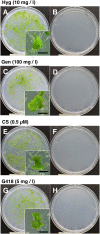Development of Gateway Binary Vector Series with Four Different Selection Markers for the Liverwort Marchantia polymorpha
- PMID: 26406247
- PMCID: PMC4583185
- DOI: 10.1371/journal.pone.0138876
Development of Gateway Binary Vector Series with Four Different Selection Markers for the Liverwort Marchantia polymorpha
Abstract
We previously reported Agrobacterium-mediated transformation methods for the liverwort Marchantia polymorpha using the hygromycin phosphotransferase gene as a marker for selection with hygromycin. In this study, we developed three additional markers for M. polymorpha transformation: the gentamicin 3'-acetyltransferase gene for selection with gentamicin; a mutated acetolactate synthase gene for selection with chlorsulfuron; and the neomycin phosphotransferase II gene for selection with G418. Based on these four marker genes, we have constructed a series of Gateway binary vectors designed for transgenic experiments on M. polymorpha. The 35S promoter from cauliflower mosaic virus and endogenous promoters for constitutive and heat-inducible expression were used to create these vectors. The reporters and tags used were Citrine, 3×Citrine, Citrine-NLS, TagRFP, tdTomato, tdTomato-NLS, GR, SRDX, SRDX-GR, GUS, ELuc(PEST), and 3×FLAG. These vectors, designated as the pMpGWB series, will facilitate molecular genetic analyses of the emerging model plant M. polymorpha.
Conflict of interest statement
Figures




References
-
- Ohyama K, Fukuzawa H, Kohchi T, Shirai H, Sano T, Sano S, et al. Chloroplast gene organization deduced from complete sequence of liverwort Marchantia polymorpha chloroplast DNA. Nature. 1986;322:572–4. 10.1038/322572a0 - DOI
Publication types
MeSH terms
Substances
LinkOut - more resources
Full Text Sources
Other Literature Sources
Research Materials

